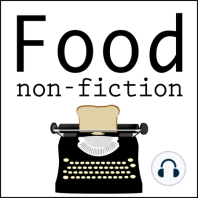1 min listen
#58 All Your Favorite Chocolates
FromFood Non-Fiction
ratings:
Length:
16 minutes
Released:
Oct 12, 2016
Format:
Podcast episode
Description
Inspired by the book, "Chocolate Wars", by Deborah Cadbury, today we're telling you the incredible true story of how how the biggest chocolate companies in the world fought for our tummies and tastebuds through innovation after innovation that eventually turned cocoa products from a drink, to an edible chocolate, to a milk chocolate powder, and finally, to our beloved milk chocolate bar. In the 1860s/70s cadbury experimented with and successfully created the first mass-manufactured chocolate bar. Milk chocolate bars did not yet exist at this time, so it would have been a plain dark chocolate bar. This was a big breakthrough. The fact that these bars could be mass-produced meant that they could be cheaper...more affordable, so more people could buy it and try it. By the 1890s, everyone in Britain was buying cocoa products - it was no longer just an exotic treat for the rich. In the decade from 1890 to 1900, the amount of cocoa consumed in Britain was doubled. Over in Switzerland, around the same time that Cadbury had managed to mass-produce their plain chocolate bar, Daniel Peter was working on making the world’s first milk chocolate powder. We know that Daniel Peter happened to be neighbors with Henri Nestlé of Nestle fame. And according to one story, Daniel had a baby daughter, named Rose, who wouldn’t take breast milk. So he asked his neighbor Henri for help, because he had just started selling a powdered milk developed for babies. So baby Rose was saved, because she could drink Nestlé’s powdered milk. At the same time her father, Daniel, got the idea to use the powdered milk to create a milk chocolate powder, which of course did not exist at the time. Although, people were already drinking cocoa powder with milk, so they would have been familiar with the flavor. In 1875, Daniel su cceeded in making the world’s first milk chocolate powder - it was called “Chocolats au Lait Gala Peter”. It was a success. He thought about making his drink into a chocolate bar...a milk chocolate bar. After years of working to create a milk chocolate bar, Daniel finally created one he could sell - he called it “Gala Peter”. The year was 1886. Elsewhere in Switzerland, at around the same time, another important chocolate innovation was happening. Rodolphe Lindt, of Lindt chocolate fame, created a much smoother chocolate after pressing the beans for longer than the norm. He experimented with different temperatures and timings to get as much cocoa butter folded into his mix as possible. This created a delicious melt-in-your-mouth chocolate. (Even today Lindt chocolates are known to be silky smooth.) He invented a machine called “a conch” because it looked like a conch shell. Chocolate bars used to be hard and gritty, but now they could be softer and smoother. So what we’re seeing at this time is more and more people getting into the business of cocoa, and working hard and innovating to get ahead. Now, back in Britain, Cadbury’s innovations made them very successful. As Quakers, George and Richard Cadbury wanted to use their money to create an ideal place for their employees to work. In 1878, they bought the idyllic land for their model factory that would be surrounded by nature. The factory was a manufacturing marvel. It was built to be one-storey tall, so that goods would not have to go up and down stairs. And they built cottages and gardens around it with spaces to play sports or relax. They called the model Town Bournville, and Bournville would be the inspiration for model towns to come. Including, the town of Hershey, which we’ve done an episode on. At around this time in the 1870s, young Milton Hershey was still in Philadelphia trying to make his candy shop successful. In England at that time the Quaker-led chocolate companies dominated. The 3 Quaker companies, Fry, Cadbury and Rowntree were all powerhouses. But they were all being threatened by European competition. You can imagine it must have been hard to compete with Lindt’s smooth chocola
Released:
Oct 12, 2016
Format:
Podcast episode
Titles in the series (75)
Promo Episode: Hello from Food Non-Fiction. This episode introduces the hosts of this podcast, Lillian Yang and Fakhri Shafai. Through this podcast, we will take you on a food journey through history and around the world. We can't wait to entertain you with stories... by Food Non-Fiction
